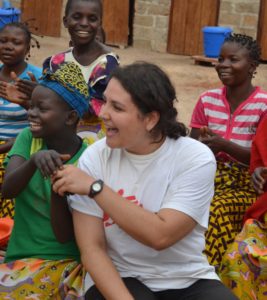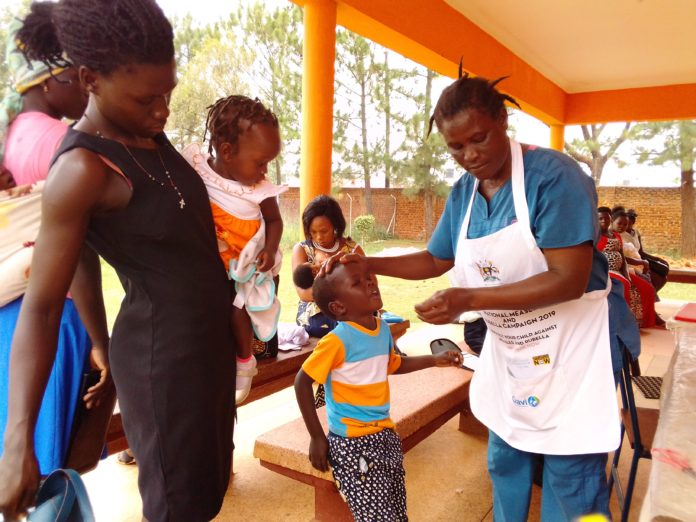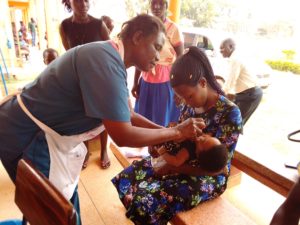|
Getting your Trinity Audio player ready...
|
By Pius Sawa
Gulu District, Northern Uganda: 24-year-old Sunday Akumu, is a mother of two living in Gulu, Northern Uganda. She was only two years old when nearly the entire population of Acholiland was displaced due to the fights between the Government forces and the Lord’s Resistance Army, LRA rebels.
A black dotted mark on Akumu’s right shoulder is a sign that she received one of the initial necessary vaccines every newborn baby should get. But perhaps that was only among the few vaccines she was able to get, following the difficult situation in the camp.
“In the camp, there were no much vaccinations. Sometimes you would miss. There were no proper hospitals. You can’t say that today is my baby’s vaccination day and I have to take the child. Sometimes you wait for six months,” recalls Akumu who grew up in Pabo Internally Displaced people’s camp in Amuru district.
Accessing vaccines in conflict areas is one of the challenges that children born or living in camps face. UNICEF estimates that today, almost 7.7 million of immunized children live in fragile or humanitarian settings, including countries affected by conflict. They are often the most vulnerable to disease outbreaks like measles and polio which can cause death or disability.
With COVID-19 pandemic that has seen countries imposing partial and total lockdowns to restrict movement and encouraging social distancing, the plight of children accessing vaccines may be more devastating. UNICEF estimates that 99% of children and young people under 18 worldwide are 2.34 billion living in one of the 186 countries with some form of movement restrictions in place due to COVID-19. 60% of all children living in one of the 82 countries with a full 7% or partial 53% lockdown accounting for 1.4 billion young lives.
 UNICEF Executive Director Henrietta Fore notes, “Unless we act now to address the pandemic’s impacts on children, the echoes of COVID-19 will permanently damage our shared future.”
UNICEF Executive Director Henrietta Fore notes, “Unless we act now to address the pandemic’s impacts on children, the echoes of COVID-19 will permanently damage our shared future.”
She says the world is already seeing disruptions in immunization services, threatening outbreaks of diseases, for which there already exists a vaccine, such as polio, measles, and cholera. “Many more newborns, children, young people and pregnant mothers could be lost to non-Coronavirus related causes if national healthcare systems already under great strain, become completely overwhelmed.”
The measles outbreak in the DRC has already killed more than 6,000, and with the ongoing Corona Virus pandemic, more lives will be lost as measures to contain the spread is enforced through social distancing.
Aloyo, now 14 years, was among the children who missed out on some of the vaccines while growing up in the camp. Today, she can’t walk because polio crippled her legs. Sharon Ajok is Aloyo’s cousin.
“The problem was due to inaccessibility to a health center. The baby developed complications, was taken to hospital for surgery but she was unable to walk. When doctors investigated, it was found that the baby did not complete the vaccines.”
When children contract measles in non-conflict settings, less than 1% of them die. UNICEF indicates that in areas where crowding and malnutrition are rife, such as refugee camps, children dying from measles can soar to up to 30% of the cases. Overcrowding and lack of basic necessities like food, water, and shelter make children even more vulnerable to disease.
“By the time I got to know what life is, I found myself in the camp,” recounts Sunday Akumu. “I didn’t know much about life outside. All we had was congestion. If you get food, you think life is good. You have no option but remain at the battlefield from the start, unlike health workers, who, sometimes would go, and sometimes they won’t. So you never know what will happen, you just wait for what comes.”
Between 1987 and 2006, more than 1.9 million people in Northern Uganda, especially the Acholi region were displaced from their homes into IDP camps and tens of thousands of Ugandan civilians died. Living conditions in the camps were horrific and for years, communities were largely cut off from basic necessities.
“Conflict creates an ideal environment for disease outbreaks,” said UNICEF Chief of immunization Robin Nandy. “Children miss out on basic immunizations because of the breakdown – and sometimes deliberate destruction-of vital health services. Even when medical services are available, insecurity in the area often prevents them from reaching children.”
Lina Zedriga Waru, is the Director, Women Peace and Security, Regional Associates for Community Initiatives, RACI. She has worked in war situations for many years.
“In a warzone medical services are a great challenge in terms of access. Many children are conceived and born in an insecure situation. As such even antenatal services are missed. They are born in the camps and miss out on the very first vaccines and then the subsequent ones.”
Government together with the churches made efforts to ensure that vaccines and medical services were occasionally taken to the camps. Through community mobilizers, mothers were informed on the day the vaccine would be delivered, and government troops provided security for the exercise.
“During the war, we used to go to a camp, after sending mobilizers to mobilize the children for vaccination,” says Joyce Alonyo Candiru, a Nursing Assistant in charge of vaccination at ST. Monica Health Center in Gulu.
However, the vaccines were always not enough, and depending on the security situation, the exercise would be abandoned immediately when reports came that the rebels were approaching.
Aloyo’s dream is now shattered because she cannot walk to school like her fellow children. She needs a wheelchair to move but still, the distance from her home in Ajulu village to the school makes it difficult for her to get to school.
For Sharon, it was only luck that she did not get polio. “Everyone was in the bushes, running or hiding, and not all children received the vaccines. I don’t think I got all the immunization,” recalls Sharon.
Sunday Akumu witnessed two of her siblings die from complications that could have been prevented.
“My mother gave birth to seven of us but she lost two of the young ones because they could not access treatment. The first one developed a high fever, was convulsing and we lost him, same to his follower. Once a child is sick, you only pray that he or she gets better. The only option is to put a child in the water and try to cool down the temperature. There is no way you could get outside the camp. So once in the camp, you only pray to God to help you.”
One of the health targets for SDG-3 is by 2030, to end preventable deaths of newborns and children under age 5 with all countries aiming to reduce neonatal mortality to at least as low as 12 per 1,000 live births and under 5- mortality to at least as low as 25 per 1,000 live births. However, the situation in warzones makes it difficult for proper documentation of how many children are born and how many get vaccinated.
According to UNICEF, of the countries in conflict, South Sudan has the highest percentage of unimmunized children with 61 percent not receiving the most basic childhood vaccines, followed by Somalia (58 percent) and Syria (57 percent).
“The priority in such conditions is safety and security. These vaccines are a luxury. It is survival. The economic costs are very grave. We have strange diseases like the notorious nodding disease that is still prevalent in the Acholi sub-region which has no cure, has killed scores of children. There is no known vaccine. Children are quarantined in designated health facilities,” observes Lina Zedriga.
Vaccine Outreaches.
At St. Monica Health center, there is an outreach vaccine program twice a week. Nurses at the health center, collect supplies from the district hospital, and travel to the villages to meet children at a central location.
“We go to the community, not the mothers coming to the health center units, but the health workers going there and educating them and giving the vaccination to the children right from the villages,” Sharon Ajok a midwife at St. Monica health center.
The center makes more than 50 vaccine outreaches in a month to save mothers from walking long distances to the health center, as well as allowing mothers to do other economic activities like farming.
“To fight poverty, we need to see mothers productive, and one way is to save them the costs of traveling long distances to vaccinate their children. When we take services to them, they will only spend a few minutes from their homes to the vaccination point and resume their farming activities”.
Solutions.
Dorine Nininahazwe, the East Africa Director for ONE appeals to governments to collaborate with other partners like the UNHCR to see that children in warzones get vaccines.
“Government should extend vaccine programs to children in warzones. Building health centers in the camps would be a good idea to protect children from falling sick because outbreaks like measles can be devastating in such camps.”
Lina Zedriga says sensitization is very critical. “Honest conversations with the affected population, redress, and working with groups such as the religious and cultural institutions, NGOs, Women groups, youth groups, schools through massive robust engagement will help address the plight of children in warzones.”
The Global Alliance for Vaccines and Immunization (GAVI) replenishment, which takes place in June this year, will be a great opportunity to appeal to governments and international partners to release more funding to support the delivery of vaccines to the needy children. GAVI is a global health partnership of public and private sector organizations dedicated to immunization for all. It has been supporting governments to vaccinate almost half the world’s children against deadly and debilitating infectious diseases.















